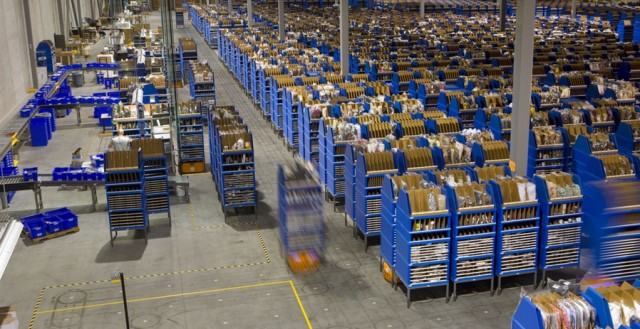Don’t tell the kiddies, but Santa’s workshop isn’t at the North Pole. It’s here in Tracy, California, next to a line of rusting, graffiti-covered freight cars, in a building so long that you can’t see the whole thing without turning your head to take in its full immensity. This is Amazon’s latest-generation warehouse, a robot-powered marvel of efficiency that in some ways feels even more improbable than flying reindeer.
In early 2012, Amazon spent $775 million to acquire Kiva Systems, a Massachusetts-based startup that makes warehouse robots and software to automate the most mundane parts of filling online orders. For the past two years, the world’s largest online retailer has kept mostly quiet about how it was using the Kiva robots in its own operations. But on Sunday, the day before the high point of the internet retail year, Amazon opened its doors to show off the droids that are taking its warehouses to the next level of consumer gratification.
The speed of commerce continues to accelerate, with Amazon setting the pace. The Tracy fulfillment center, about an hour east of San Francisco, opened last year as part of Amazon’s strategy to locate more inventory closer to population hubs. Less distance means quicker delivery, including same-day. The Kiva robots are another part of the plan to sling more goods faster than ever. Speed doesn’t come easy, but if Amazon can stay out in front, it can set the expectations that rivals will have no choice but to try to match.
The first impression at any Amazon warehouse-the company calls them “fulfillment centers”-is the noise. Plastic bins rattling over rollers, conveyer belts brimming with packages, hissing machines slapping labels onto boxes-the warehouse is a machine in constant motion. Unlike older versions of its fulfillment centers, this one has zones of quiet at its heart. The robots live here.
Inside black chain-link cages on four floors, swarms of Kiva ‘bots glide silently along an invisible grid. The squat orange automatons look like the smaller cousins of bumper cars, except they never collide. On their “backs,” the 320-pound robots carry shelves standing several feet taller than their human attendants outside the cage and weighing up to 750 pounds . Each shelf is stuffed with bins on all four sides that hold inventory-coffee mugs, Crayola markers, GoPro lens protectors, USB cables, or just about any other of around 3.5 million different items stocked by Amazon at this warehouse, known by its call sign as OAK4.
